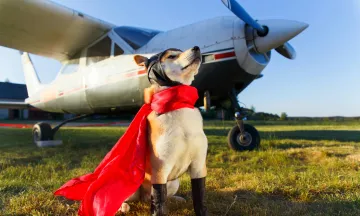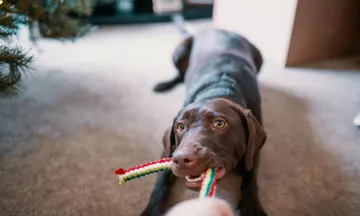Uh-oh...we see the pet cone come out at the vet and instantly feel dread – which our pet can surely pick up on!

Firstly, it’s important to remember that this uncomfortable-looking plastic ‘cone-of-shame’ is actually super important in the healing process of your cat or dog.It will stop them from licking wounds, ingesting harmful topical medications and from scratching sensitive spots after surgery. Plus, cats and dogs are a lot more adaptable then we give them credit for, so a few days of discomfort might not be as dramatic as you think!
If you know your dog or cat will soon be wearing a protective cone or e-collar, fear not. Here are some tips to make it less uncomfortable for everyone involved!
1 Stress less
As mentioned, your pet knows you like the back of their paw and will sense if you are stressed. Don’t add to the mix by smothering your pet with fretful attention while they’re recovering in their cone (though do reward them when they behave well!).
2 Be patient
The dimensions of the cone might take your pet a bit of getting used to, especially around doorways, stairs and your legs! Give them a hand where you can and don’t worry – they will soon get the hang of navigating the world in a cone.
3 Prepare the house
Move low-lying furniture and clutter out of the way, and give your pet two shallow, separate food and water bowls. You might need to elevate their food a little so they can reach it, or if worse comes to worse, remove the cone for mealtimes and water.
4 Be consistent
Try to keep the cone on as much as possible, unless you absolutely must remove it to help your pet eat (don't forget to supervise and to put it back on!). The routine will be far easier for your pet to adapt to than having the cone on for 50% of the time.
5 Practice in advance
If you can get your hands on the pet cone early, so much the better – let your pet give it a sniff and an explore. Keep the cone nearby when you feed your pet and gradually get them used to it with treats as they investigate. Give your pet a little practice in the cone, followed by praise and a treat.
6 Get the right cone
Make sure your vet fits your cone correctly, with enough space so that it doesn’t rub your pet’s neck nor slips off easily either.
7 Discuss alternatives
If your pet just doesn’t take to the cone and is really not doing well (which is more than looking miserable - we're talking refusing to eat, etc.), discuss some alternatives with your vet. While the cone is widely considered to be the most effective way to protect your pet post-surgery, there are other models that inflate or wrap around like a pillow which might be more comfortable for your cat or dog.
Consider where the wound or affected area is too, as not all protective cones will stop your pet from reaching all parts of their body.
9 Don’t feel guilty
Just don’t. You are doing this with your pet’s health as the main priority – don’t let those sad puppy-dog or puddy-tat eyes make you feel like a bad hooman! Your pet is safe, warm and loved – and once that cone comes off, they’ll forget it was ever on.
8 Enlist a sitter
A little worried about your pet during the day? Concerned they might be bumping into furniture all day and need a little space while you’re at work?
You should really have your pet supervised for the first 24 hours of cone-dom anyway. But if this is impossible for you to do, have your favourite Pawshake pet sitter pop over for a walk and a play – we promise it will brighten your pet’s day and make the cone-of-shame seem like no biggie at all!





